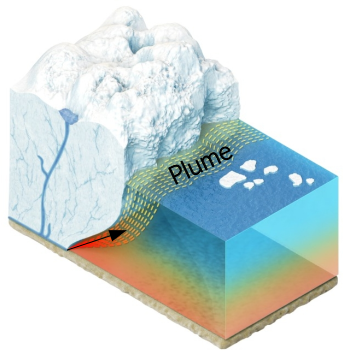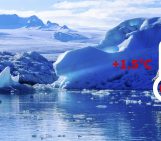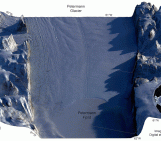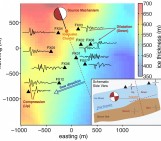
7 meters of sea-level rise – what you would get if the whole Greenland Ice Sheet melted. But the tricky question is: how much of this ice will be melted in the next decades, and how fast will it occur? This piece of information is critical in order to plan for present and future populations living in coastline areas, all around the world.
How much and how fast can the Greenland Ice Sheet melt ?
In order to answer this question, scientists use ice sheet models that incorporate many physical processes that all affect how fast the ice sheet grows or shrinks: snowfall, melting, freezing, sliding and the speed of the flowing ice. Flowing? Yes, this massive ice chunk is moving and hundreds of glaciers compose it. They transport the ice from its interior out to the open ocean. This is normal and as long there is as much snow accumulating on the surface of the ice sheet as there is ice flowing out into the ocean, the ice sheet is in balance and does not contribute to sea level rise. A similar reasoning can be applied to melting: as long that there is enough snowfall to balance out the melting, there is no reason to worry.
What is happening right now?
But climate change has already put the ice sheet into imbalance, resulting in sea level rise. The warming climate is melting more ice on the surface of the Greenland Ice Sheet than it used to. This is well captured in ice sheet models already. However, our models are having trouble in simulating what is happening under the surface for each of the hundreds of glaciers that drain the ice sheet. These glaciers are retreating and speeding up, transporting more ice into the ocean then before. But why? The models don’t seem to be able to reproduce this speed up.
The key is in the oceans. Observations show that the ocean surrounding the Greenland Ice Sheet is warming and, surprisingly, at the glacier cliffs, where the glaciers meet the ocean, water is upwelling from deep below the ocean surface. This is called a water plume and is melting the glaciers from beneath.
How does plume melting work?
As the snow melts at the surface of the glaciers, the meltwater produced on top of the glacier travels down via crevasses to the base of the glacier, where it can flow underneath the glacier, along the bedrock on which it rests, and finally into the ocean (Figure 1). This meltwater is fresh (i.e. not saline) and once it becomes surrounded by the denser, salty ocean, it will naturally start to rise due to the density contrast. Because this upwelling is turbulent, it can increase the melting of the glacier by entraining the warmer ocean water and putting it in contact with the glacier ice. Think about the ice cube in your drink. Stirring the drink – adding ‘turbulence’- will melt the ice cube faster! And if you add warmer water (the warming of the ocean), your ice cubes melt more rapidly too.
So, the warming climate is melting the Greenland Ice Sheet in two ways: at the surface, and from below through ocean mixing.
The theory is that the turbulent plume enhances glacier melt on the ocean side. As the glaciers retreat, it can push them into an unstable position (see a previous blog post about the Marine Ice Sheet Instability) and make them retreat even more, accelerating their ice loss. That sounds like a nice theory, but does this plume-driven melting really impact Greenland’s glacier dynamics and sea level rise?
Yes, it matters!
One might say that the warming ocean is the most important player in predicting future sea level rise. However, we have modeled the behavior of twelve glaciers of the Greenland Ice Sheet (Figure 2, see also Box 1 for why those twelve glaciers in particular). Our models show that adding this plume-driven melting process will increase sea level rise more than three-fold by 2100. The freshwater input from below the glaciers (the former surface melt) is just as important as the warming ocean water. Together, they drive the turbulent plume which can result in significant melting of the glaciers’ fronts and further glacier retreat.
It is important to know that this turbulent melt is not a key driver of retreat for all the glaciers of the Greenland Ice Sheet. Some of the glaciers are already close to their instability point, so any kind of melting at the glacier front is sufficient to push them into retreat. In this case, surface melting alone can be sufficient to trigger retreat. Other glaciers that sit on a prograding stable slope require much larger melt forcing to push them into retreat. We found that our twelve glaciers together showed a strong response to plume melting.

Figure 2. Greenland Ice Sheet with the twelve investigated glaciers depicted in blue. Alison Glacier (al), Daugaard- Jensen Glacier (da), Docker Smith Glacier (do), Gade (ga) Helheim Glacier (he), Jakobshavn Isbrae (ja), Kangerlussuaq Glacier (ka), King Oscar Glacier (ko), Rink Isbrae (ri), Store Glacier (st), Uper- navik Isstrom N (up), Yngvar Nielsen Glacier (yn). Credit: Johanna Beckmann and Mahé Perrette.
Box 1: We picked these twelve glaciers because they have a variety of sizes and ice discharges (ice loss into the ocean) and are situated within different climatic conditions around the Greenland Ice Sheet. Indeed, we show that if we only use a smaller glacier sample size (say, 4 glaciers), this can hugely over- or under-estimate the modeled response to plume melting. The predicted future sea level rise varies strongly with the choice of glaciers in the model. This means the choice of glaciers has to be sufficiently large and representative of all Greenland glaciers to obtain a reliable projection.
So what does that mean for Greenland?
Well, models that don’t take into account all the individual glaciers and do not consider this plume-driven melting potentially underestimate the Greenland Ice Sheet’s contribution to sea level rise. This means that the Greenland Ice Sheet could lose more ice and faster than we thought it could. In fact, our simple up-scaling calculations show that the total calculated sea level rise (from the Greenland Ice Sheet and its glaciers) should increase by more than 50% by 2100 !
And if you are curious about how the mechanisms compare in Antarctica, don’t hesitate to go read Sainan Sun’s recent blog post!
Further reading:
Beckmann, J., Perrette, M., Beyer, S., Calov, R., Willeit, M. and Ganopolski, A.(2019): Modeling the response of Greenland outlet glaciers to global warming using a coupled flow line–plume model, The Cryosphere, 13, 2281-2301, doi:10.5194/tc-13-2281-2019.
Edited by Jenny Arthur and Marie Cavitte
Johanna Beckmann is a postdoctoral researcher at the Potsdam Institute for Climate Impact Research, Germany, in the ice dynamics working group. She studies the Greenland Ice Sheet and currently focuses on extreme melt events and their impacts on the dynamical evolution of the ice sheet. Contact email: beckmann@pik-potsdam.de, tweets at @JohaBeckmann




